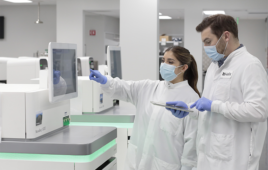
Researchers at Johns Hopkins Medicine say they have added to evidence that rapid resistance gene sequencing technology can accurately speed the identification of specific antibiotic-resistant bacteria strains that sicken and kill some patients. A report on a proof of concept study, published in the January 2019 issue of Antimicrobial Agents and Chemotherapy, suggests the technology has the potential to hasten the “personalized” choice of antibiotics critically ill patients need.
“Delays in prescribing effective antibiotic therapy for drug-resistant infections increase the risk of poor outcomes,” says Pranita Tamma, M.D., M.H.S., associate professor of pediatrics at Johns Hopkins Children’s Center and one of the study authors. “The current standard process of identifying appropriate treatment options for highly drug-resistant bacteria can take up to 96 hours from the time the lab receives samples, but our findings suggest that with the use of a rapid whole genome sequencing method, we might reduce that time to about one day less,” Tamma adds.
Tamma notes that drug-resistant bacterial infections are rising dramatically, in great part due to the overuse of antibiotic drugs and in part to the ease with which bacteria can acquire new resistance genes from other bacterial strains or species, especially in hospital settings where different strains might intermingle. Efforts to develop new antibiotics are underway but are limited, Tamma says.
The U.S. Centers for Disease Control and Prevention estimates that each year at least 2 million people develop an antibiotic-resistant infection, and at least 23,000 people die from them. Currently, typical laboratory tests to identify specific bacterial strains require 24 hours to grow the microbial culture sampled from patients, plus an additional 24 to 48 hours to determine which commonly used antibiotics would be effective against it. For bacteria resistant to multiple drugs, further tests may require an additional 24 to 48 hours more to determine what antibiotics of last resort can eradicate the infection.
For years, scientists have been able to screen bacterial genomes for specific antibiotic-resistant genes, a laborious and protracted process until the recent advent of newer technologies able to sequence and analyze bacterial genomes within hours. These technologies also offer fast ways to identify exactly what type of resistant genes the pathogens contain.
In their study designed to test the proof of concept of such methods, Tamma and Patricia J. Simner, Ph.D., D.(A.B.M.M.), the senior author of the study and an associate professor of pathology and medical microbiology at the John Hopkins University School of Medicine, used a nanopore DNA sequencer–a newer type of technology that gives results much faster than other DNA sequencing tools as it measures an electrical signal when a string of DNA moves through a tiny pore (i.e., nanopore). The electrical signal is monitored in real time, allowing for analysis of sequencing results within minutes. Other sequencers require a minimum of 24 hours before result analysis can take place.
The researchers used the new sequencer to spot antibiotic resistance genes in several strains of Klebsiella pneumoniae, bacteria that may harmlessly dwell in the human intestinal tract, but can cause serious infections if they enter the bloodstream, the urinary tract or lungs. While all typical strains of K. pneumoniae can be treated with common antibiotics such as ceftriaxone, those with acquired antibiotic-resistant genes can turn dangerous and deadly. Those most at risk are hospitalized, have been exposed repeatedly to antibiotics, or are coming from parts of the world known for high antibiotic resistance rates.
The team collected clinical samples that grew K. pneumoniae in culture from 40 adult patients hospitalized at The Johns Hopkins Hospital, extracted the bacterial DNA, and ran the DNA through the nanopore sequencer. The researchers used two different approaches to spotting the antibiotic resistance genes. A real-time analysis approach, which let researchers comb through the already sequenced genome parts while the rest of the DNA was still being read, revealed resistance genes within eight hours. An assembly-based approach took 14 hours, but proved to be more accurate and less prone to errors. The real-time approach correctly identified K. pneumoniae resistance genes and mutations in 77 percent of cases and the assembly-based one in 92 percent.
“While we still need to wait 24 hours to get the culture to grow, we were able to cut time to identifying effective antibiotic therapy by at least 20 hours, compared to our current standard of care,” says Simner. The team also believes that further automation of sample preparation could reduce the wait for optimal therapy.
Tamma and Simner caution that their study does not mean the technology is ready for clinical use, or that it will prove to be less expensive or cost-effective.
The study was limited by a small sample size and only one bacterial organism. Further studies are needed to test the new sequencer’s value with other bacteria, and the methods applied still need refinements to make it easily useful in clinical settings.
Tamma says their findings are a logical outgrowth of the commitment to precision, or personalized, medicine, which uses genetic specificity to guide treatment for patients with infections, cancer, heart disease and other disorders.
Filed Under: Genomics/Proteomics



